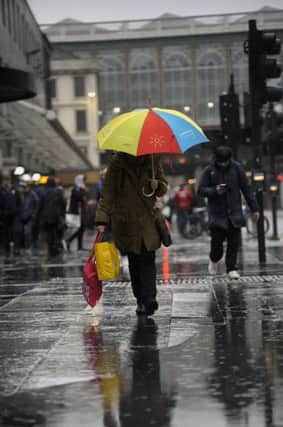Revealed: rainest city in Scotland


Edinburgh experiences the least amount of rainfall per year compared to other Scottish cities and nearly half as much as Glasgow.
Scotland’s biggest city recorded an average of 1124mm of rainfall per year with brollies at the ready on 170 of those days.
Advertisement
Hide AdAdvertisement
Hide AdIn contrast Edinburgh only had an average of 124 wet days on a par with Dundee.
And Aberdeen sheltered from 139, Stirling from 146 and there was an average of 143 rainy days in Inverness.
A formula to score how frequently it rains has been created by FreeFlush – who design systems to collect rainwater and encourage water conservation.
“An average family of four uses the equivalent of two baths of water every day just flushing the toilet. Saving water by harvesting it help make the world a greener place,” said Junaid Patel, FreeFlush. “We wanted to create the unitless measurement “rainfall days” which shows people how frequently it rains in any given place to show how often water can be collected and used in their own homes to match their demand.”
Advertisement
Hide AdAdvertisement
Hide AdAnd Glasgow scores at the top of the UK list with 2.14 “rainfall days”, followed by Cardiff at 1.91.
Edinburgh records a rain frequency of half that, at 0.98.
Aberdeen has a score of 1.26 rainfall days followed by Stirling at 1.22 and Dundee at 1.
And Mr Patel points out the importance of the acknowledging the frequency. “Although Glasgow is at the top of the Scottish list, it is third in the UK behind Cardiff and St Davids but when ranked by rainfall days, it is number one.”
But rainfall in the capital city remains unpredictable. Last year, there was an average rainfall of 681mm yet in 2015 it was 774mm. The wettest year recorded since 1959 was 2012 when Edinburgh was drenched by 959mm of rain.
Advertisement
Hide AdAdvertisement
Hide AdThis compares to a relatively dry August in 2008 which saw only 202mm of rain.
Yet, the weather in Scotland largely falls into an east/west split creating a rainier Glasgow and a drier Edinburgh.
And as Geoff Monk, of the Mountain Weather Information Service explains, Auld Reekie has the Scottish hills and mountains to thank.
“Most rainfall falls in the west is heavily influenced by the hills or mountains.
Advertisement
Hide AdAdvertisement
Hide Ad“But they have two effects; over the mountains themselves there is an increase in the rainfall – which has a bit of baring on the rainfall in Glasgow– but much more importantly, it creates a marked decrease in what rainfall you would get on the east if the mountains weren’t there.
“Make Scotland as flat as a pancake, take the mountains away, and although the pattern would be much smoother, there would be more rain in the east.”
A Met Office spokesman explained that when prevailing winds from the west bring moist air, the mountains force the air upwards.
The air rises and cools, forming rain clouds. By the time the air has passed over the mountains, much of its moisture has been lost.
Advertisement
Hide AdAdvertisement
Hide AdThis “rain shadow” is responsible for bringing drier weather to much of eastern Scotland. And as a result, Edinburgh receives only about half the rainfall of Glasgow.
Mr Monk added: “The rain shadow is carrying a certain amount of moisture, mostly vapour, and when it is forced over the mountains it falls out as rain. So by the time it reaches the east coast, Edinburgh, then it’s gone.”